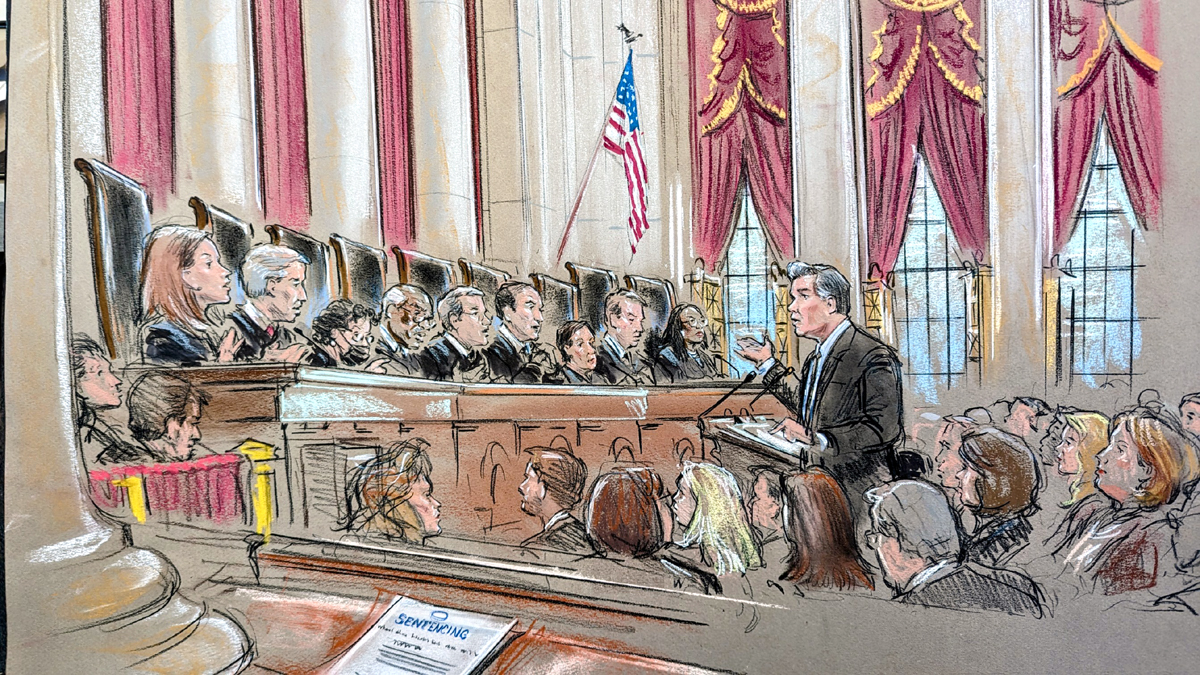ARGUMENT ANALYSIS
Court seems reluctant to extend ban on concurrent sentences in Armed Career Criminal Act

on Mar 29, 2023 at 5:30 pm

Tuesday’s argument in Lora v. United States suggested that Efrain Lora, a Bronx man convicted of killing a rival drug dealer, is likely to get his re-sentencing under the Armed Career Criminal Act. The larger question is whether the court’s opinion will take on the double jeopardy problem that looms beneath the primary statutory interpretation issue — and if it decides not to reach the double jeopardy question, how that will leave things for the lower courts.
On August 11, 2002, Lora and three lieutenants shot and killed Andrew Balcarran, a rival drug dealer, in a turf war. The murder went unsolved for a decade. In 2014, Lora was charged under 18 U.S.C. § 924(j)(1), which states in part that if a defendant “in the course of a violation of subsection (c), causes the death of a person through the use of a firearm,” he “shall be punished by death or by imprisonment for any term of years or for life” if “the killing is a murder.”
The “subsection (c)” referenced in this provision includes Section 924(c)(1)(A), which provides that anyone “who, during and in relation to any crime of violence or drug trafficking crime … uses or carries a firearm, or who, in furtherance of any such crime, possesses a firearm, shall, in addition to the punishment provided for such crime of violence or drug trafficking crime” receive a sentence of “not less than 5 years.”
Between them, Sections 924(c) and (j) authorize punishment for anyone who furthers a drug trafficking crime while using a firearm to commit a murder. This could be in addition to punishment for the underlying drug and firearm offenses. The default rule in federal court is that district judges have discretion to run multiple sentences either concurrently or consecutively. However, Section 924(c)(1)(D)(ii) specifically prohibits concurrent sentences: “[N]o term of imprisonment imposed on a person under this subsection shall run concurrently with any other term of imprisonment …” (italics added). Overruling Lora’s objection that this sentencing rule did not apply to him, the district court imposed a 25-year sentence for conspiracy to murder, to run consecutively with a five-year term for the firearm conviction.
Lora’s attorney, Lawrence Rosenberg argued on Tuesday that Section 924(c)’s special ban on concurrent sentences doesn’t apply to Lora because he wasn’t convicted under subsection (c). He was convicted under subsection (j); therefore, his sentence wasn’t imposed “under this subsection.” Moreover, there is nothing in (j) that explicitly incorporates the anti-concurrent sentence provision in (c), Rosenberg added.
When asked by Justice Clarence Thomas how the statute could have been written differently to align with the government’s view, Rosenberg responded that Congress “could have said that the bar applies to this section, not subsection … I mean, Congress could have included subsection (j) in subsection (c) at the outset, and it didn’t do that.”
In addition to his simple textual argument, Rosenberg posited that Congress affirmatively intended for the anti-concurrent sentence rule not to apply to subsection (j). But Justice Brett Kavanaugh had some friendly advice on which argument to stress. You make “the heroic effort to explain why Congress might have wanted to get to this result,” Kavanaugh said. “I think your better argument for me is that’s just what it says.”
Kavanaugh was not alone among the conservative justices in acknowledging the strength of the textual argument. Earlier in the hearing, Justice Samuel Alito prefaced a question to Rosenberg about Congress’s intent by saying, “Perhaps the text of the provision dooms the government’s position …”

Assistant to the Solicitor General Erica Ross argues for the United States. (William Hennessy)
Assistant to the Solicitor General Erica Ross pressed the government’s principal argument that subsection (j) effectively incorporates the entirety of subsection (c) by reference, including its penalty provision. According to this argument, subsection (j) only exists in conjunction with subsection (c), and they therefore constitute the same subsection for purposes of subsection (c)’s ban on concurrent sentences. But the argument quickly ran into skepticism, including from Justice Ketanji Brown Jackson. “I don’t understand why the government believes in this case that it’s entitled to the penalty structure that comes with Section (c) if a person is convicted of (c) when (j) doesn’t say and it could easily have said any person who’s convicted of subsection (c), et cetera,” Jackson said. “I think it is certainly true that Congress could have been clearer in this provision,” Ross answered. “My point was simply that it also doesn’t say what [Lora] is suggesting.”
Both in its brief and at argument, the government offered possible explanations for why Congress might have wanted the penalty provision of subsection (c) to apply to convictions under (j) and yet not say so explicitly. During her interchange with Ross, however, Justice Elena Kagan finally vocalized what she had apparently been thinking all along. Isn’t the truth of the matter here that Congress just made a mistake?” she asked.
Ross asserted that the consequences of accepting Lora’s construction of the statute would lead to results that Congress could not have intended. If the subsections were considered completely separate, and the prosecution was thereby forced to charge subsection (j) only in some cases, “then we lose the mandatory minimum consecutive penalty in (c),” Ross said. “I think that might be a case for an absurdity type of construction because it is so implausible.”
This brought Justice Sonia Sotomayor into action. “Why is it absurd? You have a sentence [under subsection (j)] that gives you permission to impose the death penalty. That’s a really big difference.”
Ross conceded that making the death penalty available in some murder cases was one “obvious” purpose of (j), “but I think there are inevitably going to be term of year sentences under (j), and in that instance, I think it is quite implausible.”
Perhaps sensing the justices’ receptivity to Lora’s textual argument, Ross offered a fallback position. “If the Court disagrees with us on [the government’s principal argument],” Ross emphasized, “I think it has to or it should say that these are separate offenses for purposes of ” Blockburger v. United States, the Supreme Court’s 1932 decision setting forth the test for when overlapping offenses are sufficiently similar to trigger the constitutional prohibition against double jeopardy. “We think, if you’re going to say, as Mr. Lora argues, that (j) does not sweep in the (c) penalties, then we think the Court should also make clear, as Mr. Lora argues, that … given the intertwined relationship between the two questions, these are separate offenses.”
That fallback position, Ross explained, is motivated by concerns about what would happen in circuits currently holding that (c) and (j) constitute the same offense for Blockburger purposes. “If you dismantle half of that without dismantling all of it, we would be in a position where courts of appeals, under their prior panel rules, might not think that they could reverse that precedent and would have to go en banc,” Ross said. “And it’s just a use of judicial resources that I think is unnecessary. Given that the parties have joined issue on this question, I think it’s well presented in the papers here.”
The government’s fallback position spawned some confusion among the justices, considering that its fallback on double jeopardy is precisely the opposite of the double jeopardy argument the government made in its brief — and continues to make as its “frontline” position.
“Can we disagree with that part of it without revisiting whether it’s one or a different offense? You’ve said two different things in that,” Jackson asked.
Thomas also sought clarification. “You were going to counsel us on how best to write an opinion if we came out in favor of Mr. Lora,” he said. “And I don’t think you quite finished.”
Ross confirmed that if the court rejects the government’s “frontline” argument — (j) and (c) constitute a single offense, and therefore Lora is subject to (c)’s penalty provisions — the court should go all the way in the opposite direction and make it clear that (j) and (c) are separate offenses — which was Lora’s position in his brief.
In his rebuttal, Rosenberg discouraged the court from taking on the double jeopardy issue in its opinion. “While we certainly did brief the issue … this case really doesn’t present the Blockburger question,” he said. “This is a case where our client could not have been charged under (c) because of the statute of limitations concern. It’s probably best left to another case to address Blockburger.”


